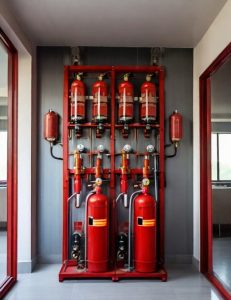![]()
Fire Immuniser
+91-7829629111
Email: info@variex.in
Varistor Technologies Pvt. Ltd.
Block-1, First Floor, Ardente Office One, Hoodi Circle, ITPL Main Road, Bengaluru, Karnataka 560048, IN
What Is Building Management System For Fire Fighting
Building Management Systems (BMS) play a vital role in ensuring the safety and security of buildings, especially when it comes to fire fighting. In this article, we will explore what a Building Management System for fire fighting entails, its functionalities, and how it contributes to the overall fire safety of a building. Let's dive right in.
What is a Building Management System for Fire Fighting?
A Building Management System (BMS) for fire fighting is a comprehensive system that integrates various fire safety and protection devices within a building. It acts as a central control unit to monitor and manage the fire safety aspects of a facility. The primary goal of a BMS for fire fighting is to enhance the overall fire safety levels by enabling early detection, quick response, and efficient control of fire incidents.
Functionalities of a Building Management System for Fire Fighting
1. Early Detection
One of the key functionalities of a BMS for fire fighting is early detection. It is equipped with fire alarm sensors, smoke detectors, heat detectors, and flame detectors strategically placed throughout the building. These sensors are connected to the BMS, which continuously monitors them for any signs of fire. Upon detection, the BMS immediately sends an alert to the building's management and the local fire department, allowing for a swift response to the fire incident.
2. Emergency Evacuation
In the event of a fire, the BMS for fire fighting takes charge of the emergency evacuation process. It activates the fire alarm system, triggering audible and visual alarms throughout the building. Additionally, it controls the emergency lighting system, ensuring proper illumination of evacuation routes and exits. The BMS also interfaces with the access control system, granting access to designated exit doors and preventing unauthorized access to affected areas.
3. Fire Suppression and Control
A BMS for fire fighting helps in effectively controlling and suppressing fire incidents. It integrates with the building's fire suppression systems, such as sprinklers, water mist systems, and gas-based extinguishing systems. Upon fire detection, the BMS automatically activates the appropriate fire suppression system, localizing the fire and minimizing damage. It also provides real-time feedback on the status of each fire suppression system, enabling prompt maintenance and refilling if required.
4. Smoke Management
Smoke is a significant hazard during fire incidents, often causing more casualties than the actual fire. A BMS for fire fighting includes smoke control features that help manage smoke levels within the building. It can activate smoke exhaust systems, pressurize stairwells to maintain smoke-free escape routes, and control HVAC systems to prevent the spread of smoke to unaffected areas.
5. Integration with Fire Department
To ensure a coordinated response and effective fire fighting, a BMS for fire fighting seamlessly integrates with the local fire department. It provides real-time information on the location of the fire, its intensity, and the status of fire safety systems within the building. This integration allows firefighters to make informed decisions and take appropriate actions quickly and efficiently.
Conclusion
In conclusion, a Building Management System for fire fighting is a critical component of a building's fire safety infrastructure. It provides early detection, efficient evacuation, effective fire suppression, smoke management, and seamless integration with the local fire department. By investing in a robust BMS for fire fighting, building owners can significantly enhance the safety of their premises and protect occupants from the devastating consequences of fire incidents. Always remember, prevention is better than cure, and a proactive approach to fire safety is essential for any building.
Frequently Asked Questions
1. What is a building management system for fire fighting?
A building management system for fire fighting, also known as a BMS for fire fighting, is a comprehensive and integrated solution that allows for the detection, prevention, and management of fire incidents in buildings or properties. It consists of various components, such as fire alarms, smoke detectors, water sprinklers, fire extinguishers, and control panels, which work together to ensure the safety of occupants and minimize the risks associated with fire outbreaks.
2. How does a building management system for fire fighting work?
A building management system for fire fighting operates by continuously monitoring the environment for any signs of fire or smoke. When a fire or smoke is detected by the sensors, the system initiates an immediate response, such as activating fire alarms, triggering water sprinklers, and notifying the building occupants and relevant authorities. The system also provides real-time information and alerts to the designated control panels, enabling the management or emergency response teams to take appropriate actions promptly.
3. What are the key components of a building management system for fire fighting?
A building management system for fire fighting typically includes several key components, such as:
- Fire alarm systems
- Smoke detectors
- Water sprinklers
- Fire extinguishers
- Control panels
- Emergency lighting systems
- Fire hydrants and hoses
- Evacuation systems
- Monitoring and notification systems
- Centralized control and management software
4. What are the benefits of using a building management system for fire fighting?
Using a building management system for fire fighting offers several benefits, including:
- Early detection of fire incidents
- Rapid response and activation of safety measures
- Minimization of property damage and loss
- Enhanced occupant safety and evacuation procedures
- Real-time monitoring and alerts for proactive fire management
- Integration with other building systems for comprehensive management
- Compliance with fire safety regulations and requirements
- Improved emergency response coordination and communication
- Centralized control and monitoring for efficient maintenance and troubleshooting
5. Can a building management system for fire fighting be customized?
Yes, a building management system for fire fighting can be customized to meet specific building requirements and fire safety needs. The system can be tailored based on the building's size, occupancy type, layout, and fire safety regulations. Customization options may include the selection and placement of fire detection devices, integration with other building systems, zoning for effective alarm management, and specific emergency response protocols. Professional fire safety consultants and system integrators can provide guidance and expertise in customizing the system according to individual building requirements.
Final Say
We at VariEx.in or Variexonline.com have mastered the art of designing, installing, inspecting, and fixing automatic sprinkler systems with the help of our in-house team, which is capable of delivering the fire sprinkler services you need, whether large or small and at affordable cost.
To schedule a fire sprinkler installation, or you think our services could benefit your commercial property, contact us online or give us a call at, 7829629111










